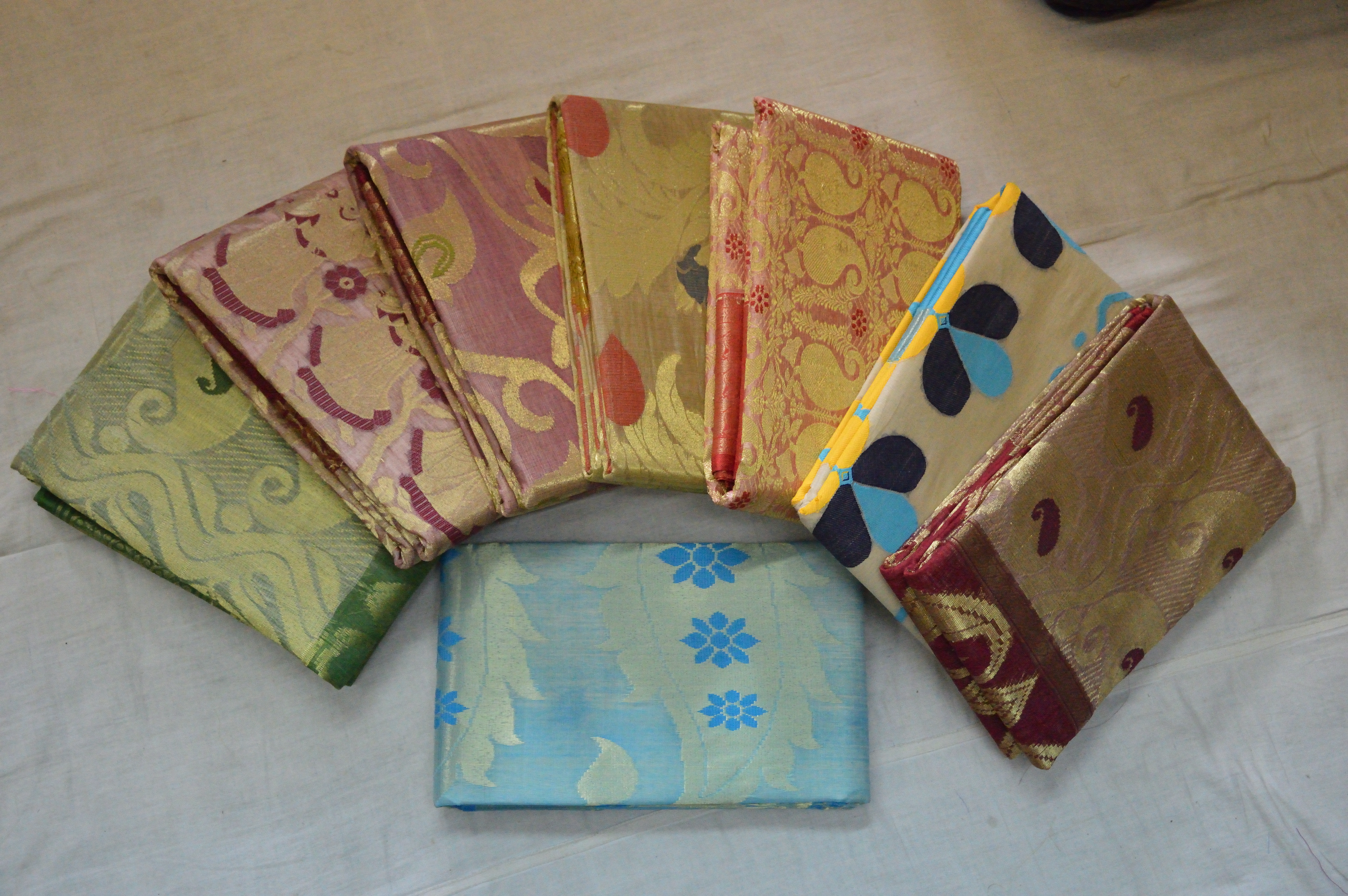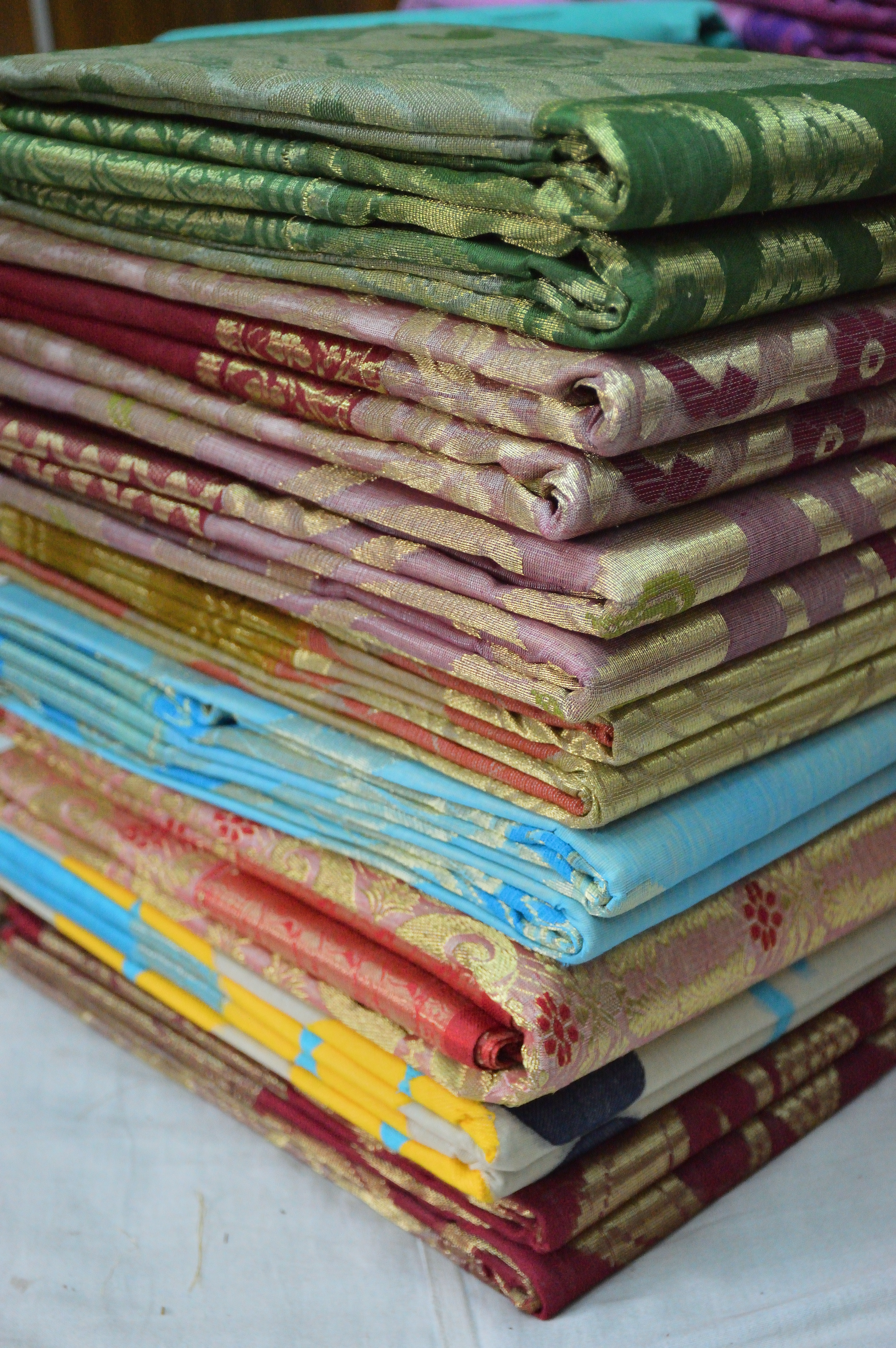Tussar Silk on:
[Wikipedia]
[Google]
[Amazon]
 Tussar silk (alternatively spelled as tussah, tushar, tassar, tussore, tasar, tussur, or tusser, and also known as (Sanskrit) ''kosa'' silk) is produced from larvae of several species of silkworms belonging to the moth genus '' Antheraea'', including '' A. assamensis'', '' A. paphia'', '' A. pernyi'', '' A. roylei'', and '' A. yamamai''. These silkworms live in the wild forests in trees belonging to '' Terminalia'' species and '' Shorea robusta'', as well as other food plants such as jamun and oak found in South Asia, eating the leaves of the trees on which they live. Tussar silk is valued for its rich texture and natural, deep-gold colour, and varieties are produced in many countries, including China,Su Jing, Lun Luo, ''Landlord and Labor in Late Imperial China: Case Studies from Shandong'', Harvard University Asia Center, 1978
Tussar silk (alternatively spelled as tussah, tushar, tassar, tussore, tasar, tussur, or tusser, and also known as (Sanskrit) ''kosa'' silk) is produced from larvae of several species of silkworms belonging to the moth genus '' Antheraea'', including '' A. assamensis'', '' A. paphia'', '' A. pernyi'', '' A. roylei'', and '' A. yamamai''. These silkworms live in the wild forests in trees belonging to '' Terminalia'' species and '' Shorea robusta'', as well as other food plants such as jamun and oak found in South Asia, eating the leaves of the trees on which they live. Tussar silk is valued for its rich texture and natural, deep-gold colour, and varieties are produced in many countries, including China,Su Jing, Lun Luo, ''Landlord and Labor in Late Imperial China: Case Studies from Shandong'', Harvard University Asia Center, 1978
 India is the second-largest producer of tussar silk, and the exclusive producer of Indian tussar (also known as tropical tussar), which is largely tended to by tribals. Much of it is produced in
India is the second-largest producer of tussar silk, and the exclusive producer of Indian tussar (also known as tropical tussar), which is largely tended to by tribals. Much of it is produced in
India
India, officially the Republic of India, is a country in South Asia. It is the List of countries and dependencies by area, seventh-largest country by area; the List of countries by population (United Nations), most populous country since ...
, Japan
Japan is an island country in East Asia. Located in the Pacific Ocean off the northeast coast of the Asia, Asian mainland, it is bordered on the west by the Sea of Japan and extends from the Sea of Okhotsk in the north to the East China Sea ...
, and Sri Lanka
Sri Lanka, officially the Democratic Socialist Republic of Sri Lanka, also known historically as Ceylon, is an island country in South Asia. It lies in the Indian Ocean, southwest of the Bay of Bengal, separated from the Indian subcontinent, ...
.
Process
To kill the silkworms, the cocoons are dried in the sun. A variation of the process exists in which the silkworms are allowed to leave before the cocoons are soaked in boiling water to soften the silk, and then the fibers are reeled. Single-shelled, oval-shaped cocoons are collected and then boiled to extract the silk yarn. Boiling is a very important part in the manufacturing of silk, as it softens the cocoon and makes the extraction of silk easier. In conventional sericulture, the cocoons are boiled with the larvae still inside, but if the cocoons are boiled after the larvae have left them, the silk made is then called "nonviolent silk" or " Ahimsa silk". In China, the silks are given different names when silkworms are reared on different plants, as the diet of the silkworms has an effect on the quality of the silk. For example, silk from larvae on the wild mulberry is called ''zhe'', while those on the oak '' Quercus dentata'' produce ''hu''. Tussar silk is considered more textured than cultivated '' Bombyx'' or "mulberry" silk, but it has shorter fibres, which makes it less durable. It has a dull, gold sheen. As most of the cocoons are collected from the forest, it is considered by many as a forest product.Production in India
Bhagalpur
Bhagalpur, historically known as Champapuri, Champa Nagari, is a city in the Indian state of Bihar, situated on the southern bank of the Ganges river. It is the Bihar#Government and administration, third largest city of Bihar by population and ...
(where it is called Bhagalpur silk), Bihar
Bihar ( ) is a states and union territories of India, state in Eastern India. It is the list of states and union territories of India by population, second largest state by population, the List of states and union territories of India by are ...
, and Malda district
Malda district, also spelt Maldah or Maldaha (, , often ), is a district in West Bengal, India. The capital of the Bengal Sultanate, Gauda and Pandua, was situated in this district. Mango, jute and silk are the most notable products of this ...
of West Bengal
West Bengal (; Bengali language, Bengali: , , abbr. WB) is a States and union territories of India, state in the East India, eastern portion of India. It is situated along the Bay of Bengal, along with a population of over 91 million inhabi ...
. Tussar silk is also used for Odisha
Odisha (), formerly Orissa (List of renamed places in India, the official name until 2011), is a States and union territories of India, state located in East India, Eastern India. It is the List of states and union territories of India by ar ...
's ''pattachitra
Patachitra or Pattachitra is a general term for traditional, cloth-based scroll painting, based in the eastern Indian States and territories of India, states of Odisha, and West Bengal as well as parts of Bangladesh. Patachitra art form is known ...
'' and West Bengal's '' kantha'' stitches. Chhattisgarh
Chhattisgarh (; ) is a landlocked States and union territories of India, state in Central India. It is the List of states and union territories of India by area, ninth largest state by area, and with a population of roughly 30 million, the List ...
and Madhya Pradesh
Madhya Pradesh (; ; ) is a state in central India. Its capital is Bhopal and the largest city is Indore, Indore. Other major cities includes Gwalior, Jabalpur, and Sagar, Madhya Pradesh, Sagar. Madhya Pradesh is the List of states and union te ...
also produce tussar silk. In recent years, the state of Jharkhand
Jharkhand (; ) is a States and union territories of India, state in East India, eastern India. The state shares its border with the states of West Bengal to the east, Chhattisgarh to the west, Uttar Pradesh to the northwest, Bihar to the north ...
has emerged as the biggest producer of tussar silk.
Bhagalpur silk
The tussar silk-weaving industry inBhagalpur
Bhagalpur, historically known as Champapuri, Champa Nagari, is a city in the Indian state of Bihar, situated on the southern bank of the Ganges river. It is the Bihar#Government and administration, third largest city of Bihar by population and ...
, more than a century old, has about 30,000 handloom weavers working on some 25,000 handlooms. The total value of annual trade is around Rs 100 crore
Crore (; abbreviated cr) denotes the quantity ten million (107) and is equal to 100 lakh in the Indian numbering system. In many international contexts, the decimal quantity is formatted as 10,000,000, but when used in the context of the India ...
s, about half of which comes from exports.
Uses
The ''saree'' is the most important tussar silk product although it is also used as the base material for handicrafts, furnishing fabrics, and stitched apparel. With the introduction of chemical dyes, the range of available colors has increased significantly. Some fashion designers use tussar silk in their creations. The precisely finished and designer garments produced from tussar silk are known globally and are exported worldwide. Tussar silk is a popular additive tosoap
Soap is a salt (chemistry), salt of a fatty acid (sometimes other carboxylic acids) used for cleaning and lubricating products as well as other applications. In a domestic setting, soaps, specifically "toilet soaps", are surfactants usually u ...
. The short silk fibers are typically dissolved in lye water, which is then added to oils to make soap. Soap made with tussar silk has a "slippery" quality and is considered more luxurious-feeling than soap made without. Tussar silk roving can be bought at soapmaking supply stores.
References
{{Saree Silk Silk production Silk in India Indian clothing Woven fabrics Antheraea